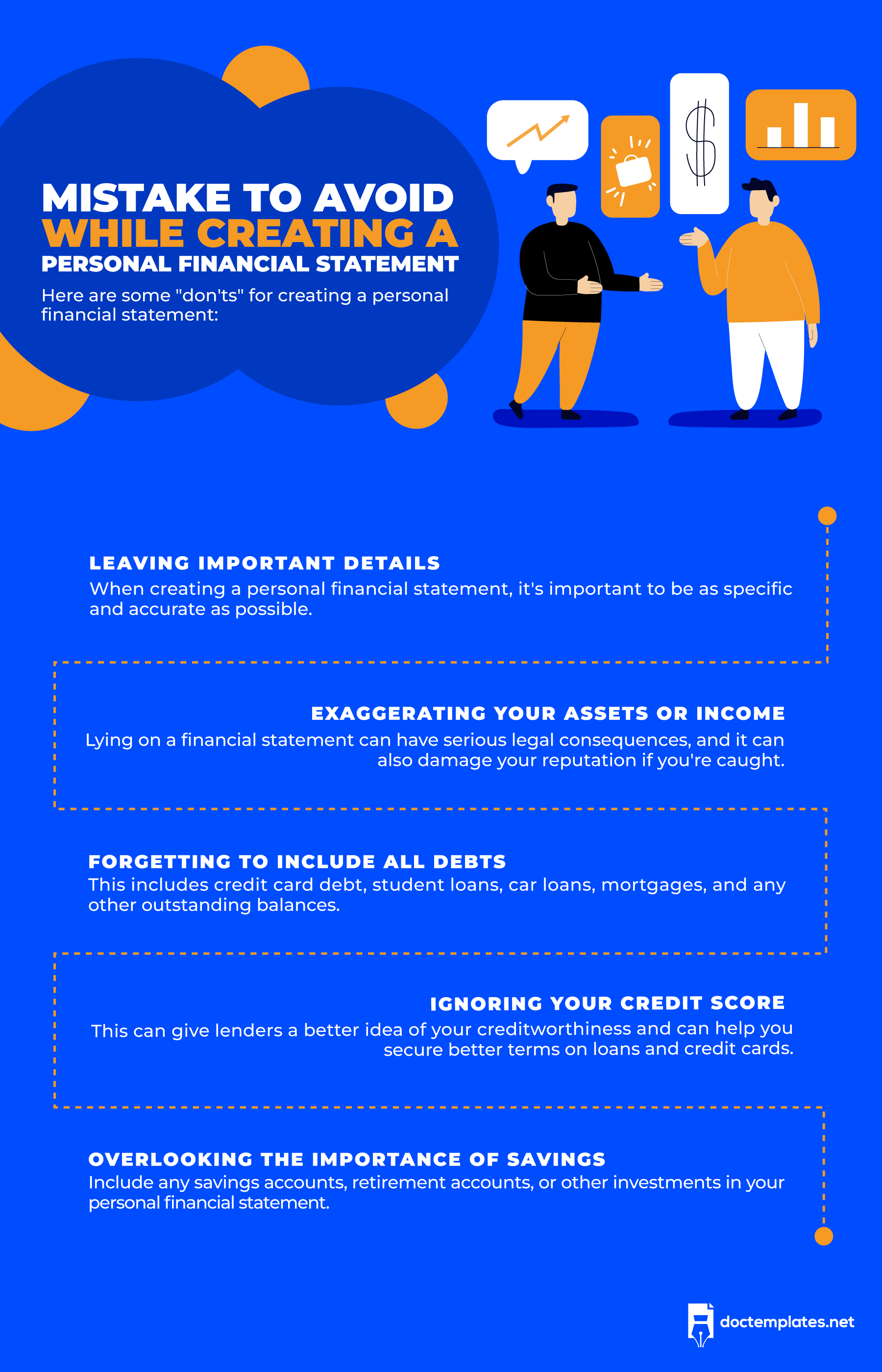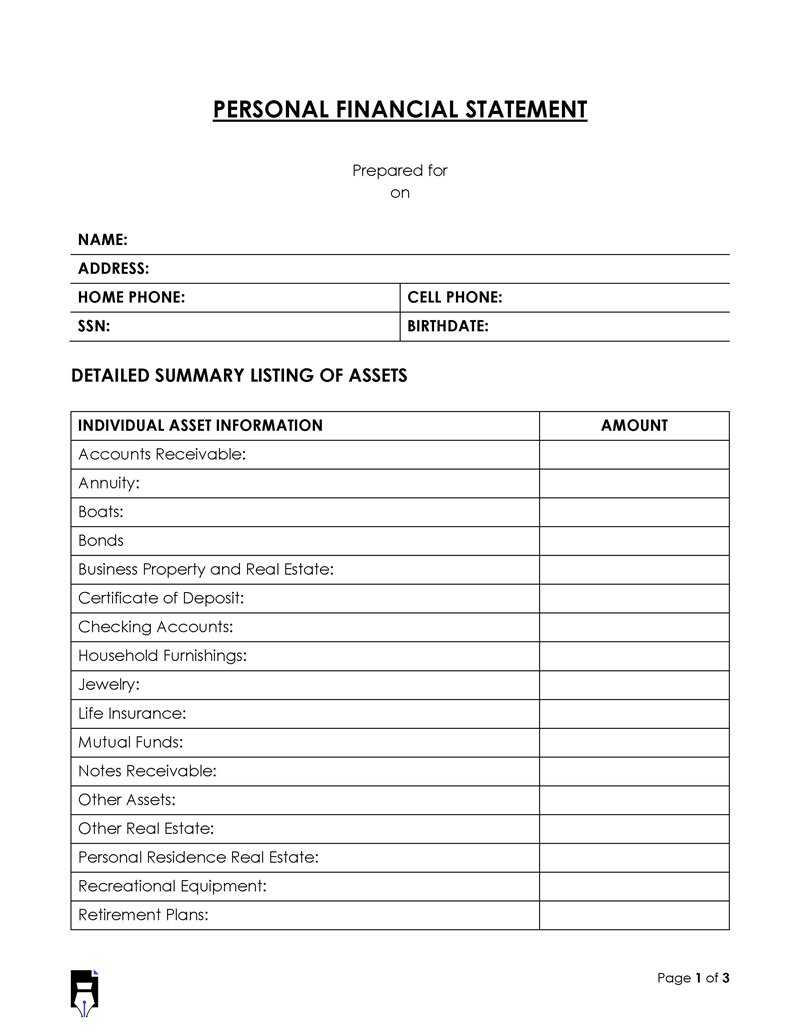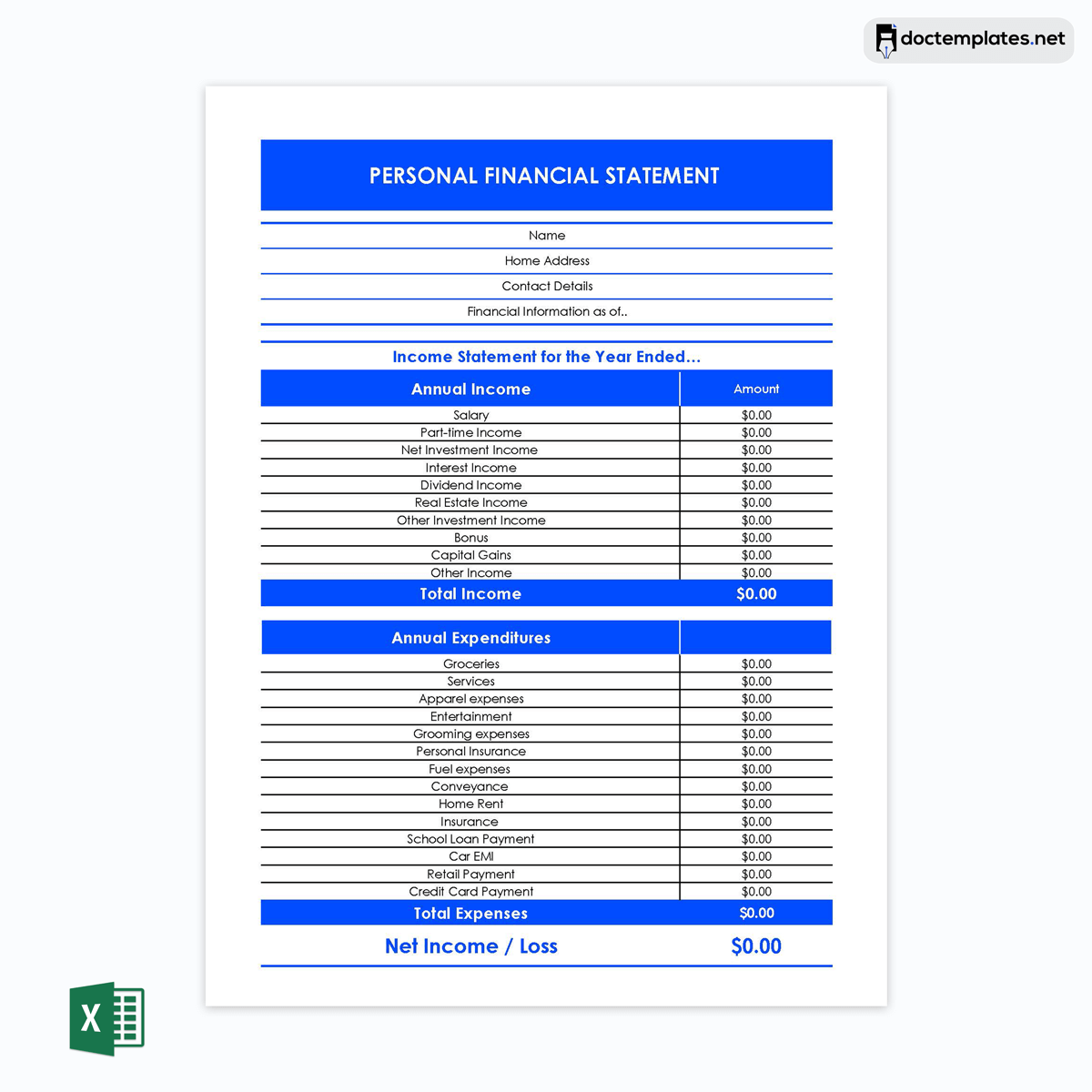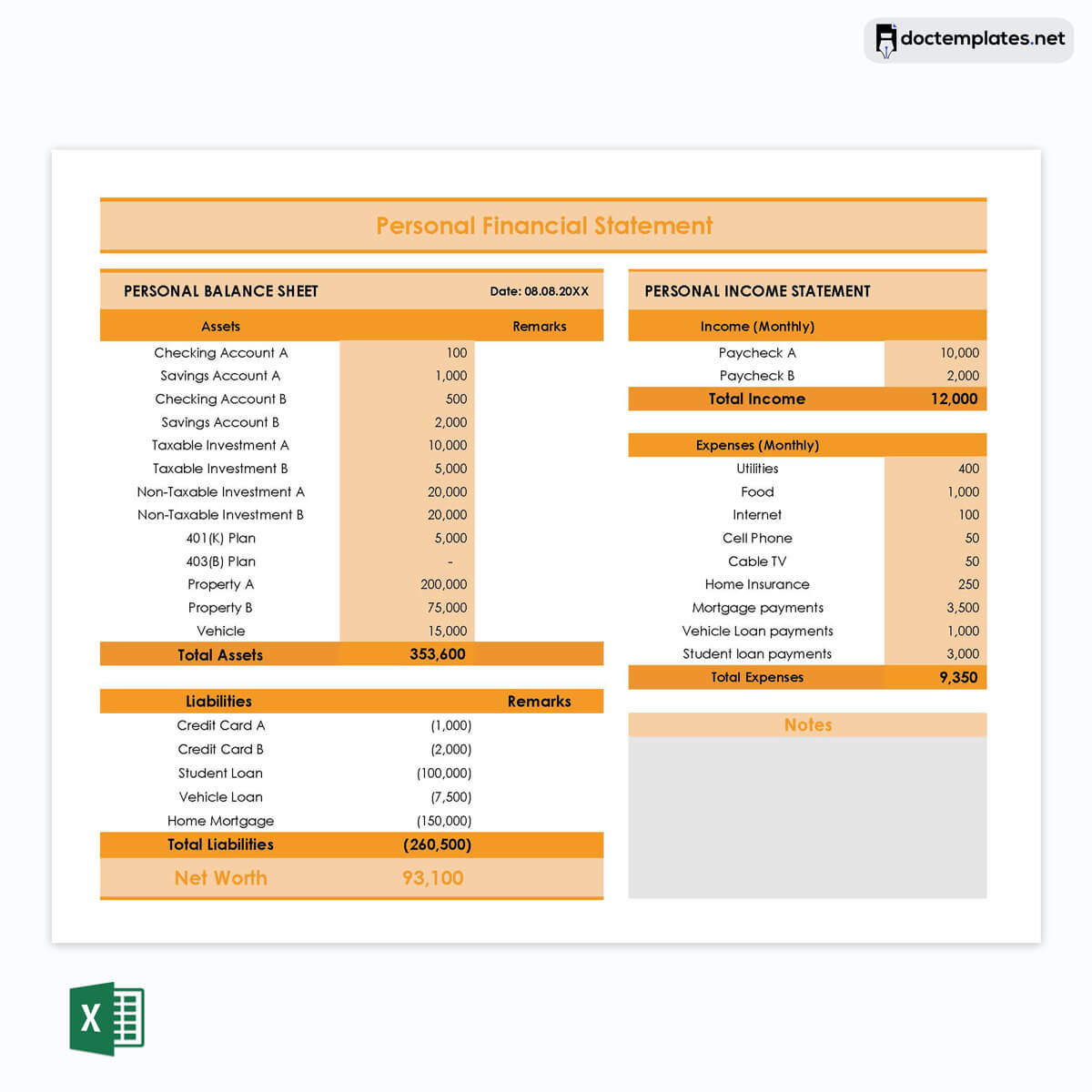A personal financial statement is a document that outlines an individual’s financial status, overall earnings, and activities over a specific period.
This includes salary earned, assets, and liabilities. The assets may include real estate, land, insurance policies, shares, and cash and cash equivalents such as savings. The liabilities may include short-term debts, wages payable, dividends payable, credit cards, long-term dents, capital lease obligations, mortgages, and deferred tax liabilities. In addition, the statement breaks down how the earnings are distributed in terms of expenses, taxes, and investments.
The essence of a financial statement is to provide an individual with an overview of their personal financial status. By understanding such situations, one can make better and optimal decisions. Furthermore, it can be used when applying for financial credits.
For instance, mortgages and loans, such as personal, payday, auto, and other forms of loans. Financial institutions such as banks and credit unions use this information to gauge an individual’s creditworthiness. Therefore, creditors use these financial statements to measure an individual’s ability to repay the loan on time and uphold the loan agreements.
Therefore, a personal financial statement solely focuses on an individual’s financial abilities and status. In this article, you will learn more about who can create a personal financial statement and how it can be made in MS Excel. In addition, you will also learn about why using a template to create this statement is essential.
Financial Statement Templates
You can download the following templates for free:
Who Creates Personal Financial Statements?
An individual trying to understand their personal financial status or situation can create a statement. Notably, an aspiring entrepreneur can seek professional advice and assistance from advisors and certified public accountants when creating it.
Besides knowing and understanding the financial status, these statements can be used to persuade potential investors to invest in the new business. Additionally, it can be created when the individual wants to apply for financial aid in terms of loans.
Remember that a personal financial statement is different from other financial statements. This is because the personal statement allows you to present your financial standings, motivating investors and creditors to join your newly opened business. This statement will highlight your finances until your business acquires a financial history of profits and losses that can be used in a statement that focuses on the business itself.
It can be challenging to create a perfect financial statement. However, with our templates, you will have an opportunity to create an effective one effortlessly. They can be customized to meet all your requirements. Furthermore, you can re-use them whenever you want to check your financial status or calculate your net worth. Note that you can access and download these templates from our website for free.
How to Create Personal Financial Statement Template in MS Excel
When preparing your personal financial statement, there are basic components that you should include in the template. The idea is to have a formal record of your financial activity to determine your creditworthiness.
Below is an extensive step-by-step guide that will help you create a template in Excel when preparing a statement for your personal finances:
Step 1: Create a spreadsheet
Start by creating a spreadsheet in Excel with different sections for adding personal information and recording assets, liabilities, income, expenses, and net worth. Each section should be in its own cell to allow for proper calculations of your net worth.
Step 2: Include your personal information
Proceed to include your personal information in the template of your financial statement. This includes your full official name, address, telephone number, and other relevant contact details, such as your email address. This is meant to identify you as the owner of the financial statement. For instance, the bank or lender can easily contact you if you want to take a mortgage.
Go to row A1 of the Excel sheet and write ‘Personal Financial Statement.’ Proceed to include your details in the cells that follow. Adjust the size of the cells depending on the content you have written.
Step 3: List your assets and their worth
At this point, you should list all your assets; these are all the things that you own. They may include cash in hand, owned real estate, mineral rights, riparian rights, and oil and gas rights. Other assets include checks and savings account balances, the value of stocks or annuities, the balance of retirement accounts, and valuable assets such as fine art or rare coins.
These assets are usually divided into fixed assets, such as property; intangible assets, such as copyright; and current assets (which can be liquidated within a year), such as savings accounts. You can show this division in your financial statement or make it simple by just listing your assets. Each asset you own should be listed in its cell, and the value or worth of that asset should be indicated next to it. Ensure you use the dollar value of the asset.
After including the personal information, go to the next row, for instance, row A7 and name it Assets. Below it, include your assets in the cells going down. Adjacent to each asset, include its worth in the cells available.
Step 4: Add individual liability information
You should also include all your liabilities in the template. These are things on which you owe money. They may include balances on personal loans, credit card balances, small claims or other court judgments against you, and unpaid state or federal taxes. Ensure you format them just like the assets.
You should divide your liabilities into current and long-term ones for this section. Current liabilities include employees’ wages, credit cards, or even money to be paid to suppliers. Long-term liabilities, such as long-term loans and bonds payable, entail those that will be paid for over a year.
Go to the next row, for instance, A13, and name it Liabilities. Proceed to include your liabilities in the cells below it, going downwards. Adjacent to each liability, include its worth in the cells available in the Excel sheet.
Step 5: Record your monthly income
Your personal financial statement should also include a record of your monthly income. This is the total amount of money you earn per month. Ensure you list your source of income and the amount you receive from that source. These sources may include salary, part-time income, dividend income, net investment income, real estate income, bonuses, and capital gains.
In Excel, go to the next available row, A17, and name it Income. Proceed to list all your income sources and include the amount you receive from each source in the adjacent cells going downwards.
Note: This section is not necessarily required in a financial statement. However, it is necessary to include it if you apply for a personal loan.
Step 6: Register your monthly expenses
After your income section, ensure that you include an expenditure section in the template. This will include all your monthly expenses and help you determine your financial health and stability. You can easily find the areas you need to change by highlighting your expenses.
For the monthly expenses, go to the next row in your Excel spreadsheet. For instance, A25 and name it monthly expenses. Then, list all your monthly expenses and include the amount you spend on the adjacent cell of each expense.
Step 7: Determine the total of assets and liabilities
At this point, you should use the SUM formula in Excel to determine the total for assets and liabilities. The total for each should be placed directly under the appropriate section. Below the assets section, for instance, at row A12, proceed to name it ‘Total assets’ and write the formula = SUM (B9, B10, B11). The same should be done for liabilities under ‘Total liabilities’ with the formula = SUM (B9, B10, B11).
Note: You can use the same SUM formula to determine your total income and expenses.
Step 8: Calculate your net worth
You can now calculate your net worth with the total assets and liabilities. You should subtract your total liabilities from your assets to determine your net worth. In the appropriate cell, for instance, A32, include the formula =(A12-A18) to calculate your net worth.
(NET WORTH= TOTAL ASSETS – TOTAL LIABILITIES)
Following the steps provided, your personal financial statement should be complete with all the required sections/components.
Step 9: Save and print
Since your template is complete, save it for printing for future or current use. You can continue to format your document as you wish to ensure that you have an effective statement for your finances.

Summary
A financial statement is a crucial document that allows you to know your personal financial status. As a result, you should create an effective financial plan that does not affect your finances. Importantly, you can make accurate and informed financial decisions with this statement. Therefore, creating or using a ready-made template is an effective and efficient way of preparing a perfect financial statement using Excel. These documents will depict your financial status accurately. Also, these templates will help you gain financial insights that will improve your financial health and positively impact your decision-making process for the future.


